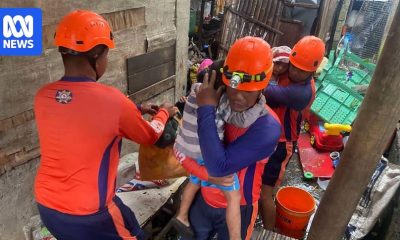Health
Debate rages over whether coronavirus can be spread via airborne transmission – 7NEWS.com.au
The World Health Organisation says coronavirus can be spread through tiny droplets that linger in the air. Some experts aren’t convinced.

The World Health Organisation has expanded its coronavirus guidance to include the possibility in certain circumstances of airborne transmission, in which the virus could be spread through tiny droplets that linger in the air.
The update came Thursday after an open letter signed by more than 200 scientists pressed the agency this week to acknowledge the potential role that tiny droplets, or aerosols, play in airborne transmissions among people in crowded, indoor settings for prolonged periods of time.
Watch the video above
There have been reported outbreaks of COVID-19 in some closed settings, such as restaurants, nightclubs, places of worship or places of work where people may be shouting, talking, or singing, the WHO said in its updated review of the evidence.
In these outbreaks, aerosol transmission, particularly in these indoor locations where there are crowded and inadequately ventilated spaces where infected persons spend long periods of time with others, cannot be ruled out.
The agency said more research is urgently needed to investigate such instances and assess their significance for transmission of COVID-19.
The WHOs expanded guidance on airborne transmission is notable, but experts maintain that aerosols are likely to be just a small part of how the coronavirus spreads and that close contact with an infected person is still the most common source of transmission.
You can put all these definitions in place, but weve always been concerned about spread when people are in small spaces, indoors, for long periods of time, said Cindy Prins, an epidemiologist at the University of Florida in Gainesville.
Airborne transmission occurs when tiny aerosol particles are expelled by talking, sneezing or coughing but then remain suspended in the air. Credit: Getty
For respiratory illnesses like COVID-19, the disease caused by the coronavirus, the medical community focuses on two primary ways that the virus can spread: airborne transmission and whats known as droplet transmission.
With droplet transmission, its thought that virus-filled particles can be ejected from the mouth or the nose when a person speaks, coughs or sneezes.
The droplets can be flung through the air, but then drop to the ground or onto other surfaces fairly quickly if they dont come into contact with other people nearby.
Airborne transmission, on the other hand, occurs when tiny aerosol particles are expelled by talking, sneezing or coughing but then remain suspended in the air.
The minuscule particles can also travel away from an infected person by floating on air currents.
Measles, chickenpox and tuberculosis are other diseases that can spread through airborne transmission.
US infectious diseases expert Anthony Fauci says there is ‘no solid evidence’ of airborne transmission, but it can’t be ruled out. Credit: AP
When asked about airborne spread of coronavirus, Dr Anthony Fauci, director of the National Institute of Allergy and Infectious Diseases said, Theres no solid evidence that that type of transmission is occurring.
But he added, We cant rule it out completely.
Chevron Right Icon
Theres no solid evidence that that type of transmission is occurring.
While airborne and droplet transmission are different, they arent mutually exclusive, said Dr Isaac Bogoch, an infectious diseases physician who is an associate professor of medicine at the University of Toronto.
We often think about these clinical definitions as silos, but thats not entirely accurate, Bogoch said.
Theres a spectrum from droplets all the way to airborne.
When we think about COVID-19, there may be some airborne transmission, but its safe to say that the majority of transmission falls toward the droplet side of the spectrum.
Bogoch pointed to hospital protocols as a key indicator that airborne transmissions are likely to be rare.
When treating coronavirus patients, most hospitals have been adhering to infection control guidelines tailored to droplet transmission, rather than the more stringent procedures to protect against airborne infections.
If COVID-19 was truly airborne, Bogoch said, infection rates among health care workers would have skyrocketed.
Our personal protective equipment our masks, gowns, gloves and eye protection are chosen for droplet precautions, and the vast majority of the time when we have access to these things and we use them correctly, were not getting this infection, he said.
Health workers’ personal protective equipment is chosen for droplet precautions. Credit: Getty
Dr Carlos del Rio, executive associate dean of the Emory University School of Medicine in Atlanta, said that aerosol transmission is likely to be a risk in certain conditions but that the WHOs updates dont represent a drastic departure from what was already known.
If Im in a crowded room with a bunch of infected people, theres bound to be aerosol transmission there, but if Im in a big room or Im outside and someone is walking nearby, Im not too worried about aerosols, he said.
Prins said the updated information should reinforce recommendations from public health officials that are already in place, such as practising social distancing and avoiding congested indoor spaces.
And regardless of whether its mandated, people should wear masks in public, del Rio said.
Everyone should wear a mask, he said.
We have to get it across to people that this is not an option.

-

 General16 hours ago
General16 hours agoFrom jackaroo to ‘Golden Tonsils’ radio titan: the life and career of John Laws
-

 General19 hours ago
General19 hours agoMajority of Australia’s first Ashes Test squad to feature in Sheffield Shield round four
-

 General21 hours ago
General21 hours agoAustralia beats New Zealand 40-8 to defend Women’s Pacific Cup crown
-

 General12 hours ago
General12 hours agoSuper Typhoon Fung-wong makes landfall in the Philippines
